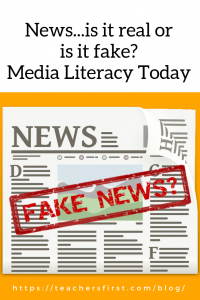 The New York Times was first published on September 18, 1851! The world was a very different place then. Today the words Fake News are a stark reminder of the amount of information our students receive every day. How can we help our students know what is real and what is fake? By teaching Media Literacy. According to the Center for Media Literacy, Media Literacy is the ability to access, analyze, evaluate and create media in a variety of forms. Media Literacy is an important topic that all teachers should be involved in teaching.
The New York Times was first published on September 18, 1851! The world was a very different place then. Today the words Fake News are a stark reminder of the amount of information our students receive every day. How can we help our students know what is real and what is fake? By teaching Media Literacy. According to the Center for Media Literacy, Media Literacy is the ability to access, analyze, evaluate and create media in a variety of forms. Media Literacy is an important topic that all teachers should be involved in teaching.
Many organizations provide a variety of resources for students and teachers. The National Association for Media Literacy Education provides resources like the media lit one sheet, which is a guide to asking the right questions to evaluate media. The Center for Media and Information Literacy furnishes a page of education resources. The Media Education Lab maintains a collection of media literacy curriculum materials. The Media Spot provides a Media Literacy Scope and Sequence. The New York Times produced a teacher resource entitled “Evaluating Sources in a ‘Post-Truth’ World: Ideas for Teaching and Learning About Fake News.”
We can present our students with resources that will help them determine if an article or website is real or fake like:
- FactCheck.org – whose mission states they are: a nonpartisan, nonprofit “consumer advocate” for voters that aims to reduce the level of deception and confusion in U.S. politics
- Politifact.com – focused on looking at specific statements made by politicians and rating them for accuracy
- Snopes.com – an online touchstone of research on rumors and misinformation
- Washington Post Fact Checker
- WhoIs – Internet domain checker
- Kathy Schrock’s 5Ws of Website Evaluation
- RADCAB – website evaluation tool
Try out an interactive activity with students!
- Factitious test your news sense with this game
- Common Sense Education’s 5 Questions to Ask About Media worksheet
- Canada’s Media Smarts educational games
- The Federal Trade Commission’s Admongo interactive advertising game
- Media Education Lab’s My Pop Studio game
- Prodigy’s 10 engaging media literacy activities
We can all celebrate the New York Times’ anniversary by helping our students to become media literate! Be sure to check out the TeachersFirst media literacy resources like the Media Literacy special topic collection and previous blog posts Media Messages Matter and Media Literacy in a Presidential Election Year.


Last week in one of my science classes we watched an awesome Ted Talk about this topic. Especially in science, click bait and catchy headlines often leads to very bad science but with today’s quick feedback society it gets accepted as fact. In science, it is extremely important to know before you really believe something or take something as true you need to go to the primary research and look at the data yourself!
Exactly! Check out our upcoming blog with more tips for fake news.